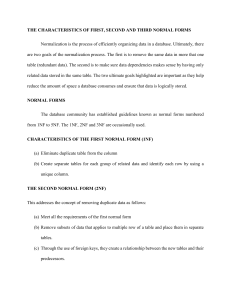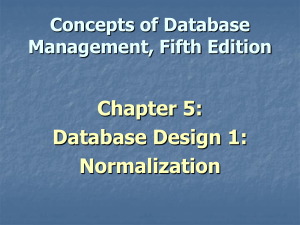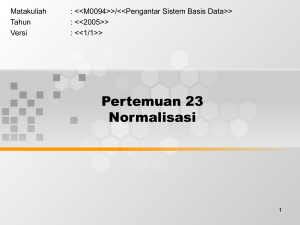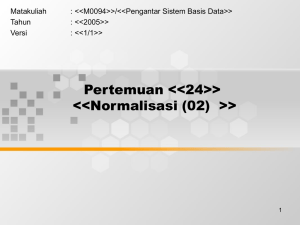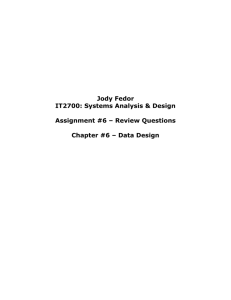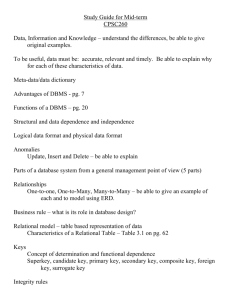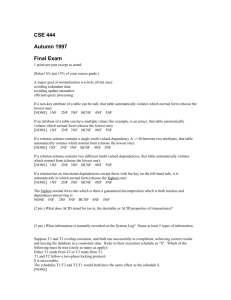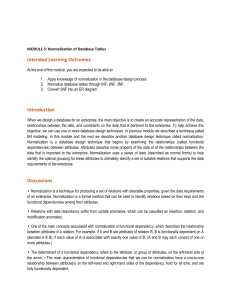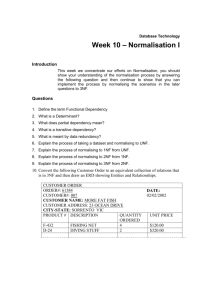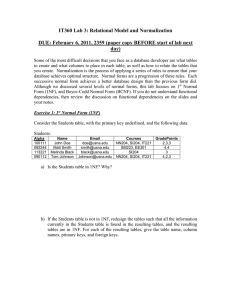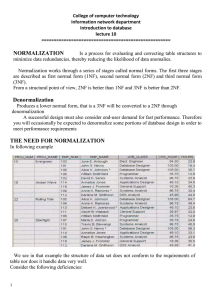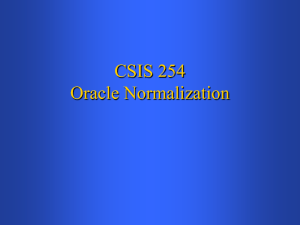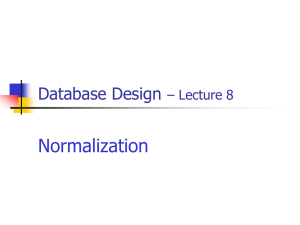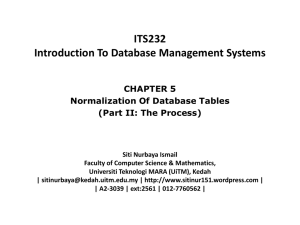Chapter 5: The Relational Model and Normalization
advertisement
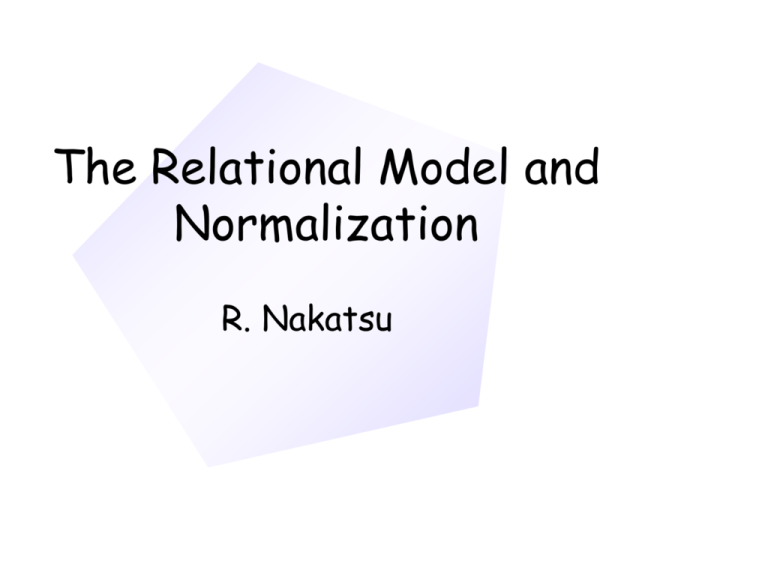
The Relational Model and Normalization R. Nakatsu The Relational Model • Data is represented in two-dimensional tables – Each of the tables is a matrix consisting of a series of row/column intersections – Tables are also called relations – Columns of the tables are attributes • Information in more than one table can be easily extracted and combined • E.F. Codd defined well-structured “normal forms” of relations Functional Dependency Notation: X Y Each value of X determines one and only one value of Y Examples: SID Major, LastName, FirstName ComputerSerialNumber MemorySize (SID, CourseNumber) Grade Functional Dependency What are the functional dependencies in the relation below? A B relationships A B and B A A B but B not A A not B and B not A one-to-one many-to-one many-to-many Another way to write not is . For example: A B and B A (A multi-determines B and B multi-determines A) Key A group of one or more attributes that uniquely identifies a row. A relation has one primary key and may also have additional keys called candidate keys. Composite Key is a key that contains two or more attributes Normalization Normalization is a process that assigns attributes (fields) to tables such that data redundancies are eliminated or reduced, thereby reducing the likelihood of data anomalies. Stages of Normalization (Normal Forms): 1NF, 2NF, 3NF, BCNF, 4NF (Ensure that tables are at least 3NF; higher forms are far less likely to be encountered). Normalization Process Objective: Ensure that each table conforms to the concept of well-formed relations. – Each table represents a single subject – No data item will be unnecessarily stored in more than one table – All nonkey attributes in a table are dependent on the primary key – Each table is void of insertion, update, and deletion anomalies Anomaly An undesirable consequence of data modification in which two or more different themes are entered (insertion anomaly) in a single row or two or more themes are lost if the row is deleted (deletion anomaly). Example State the deletion and insertion anomalies. SID 100 100 150 175 175 200 200 Activity Skiing Golf Swimming Squash Swimming Swimming Golf Fee 200 65 50 50 50 50 65 First Normal Form (1NF) Any table of data that meets the definition of a relation: • • • • • • No multi-valued attributes allowed. No repeating groups. No two rows can be identical (need a primary key). Order of the rows is insignificant. All entries in a column are of the same kind. Each column must have a unique name. Table Not in 1NF Table Not in 1NF Table Not in 1NF Order Table Attributes 1. 2. 3. 4. 5. 6. 7. 8. 9. 10. 11. 12. Order ID Order Date Shipping Date Customer ID Customer Name Shipping Address Book 1 Title Book 1 Price Book 1 Qty Book 2 Title Book 2 Price Book 2 Qty 13. 14. 15. 16. 17. 18. 19. 20. 21. Book 3 Title Book 3 Price Book 3 Qty Book 4 Title Book 4 Price Book 4 Qty Book 5 Title Book 5 Price Book 5 Qty (Title, Price, Qty) is a repeating group Second Normal Form (2NF) If it is in 1NF and all its nonkey attributes are dependent on all of the key. No partial dependencies are allowed. Partial dependency: Functional dependence in which the determinant is only part of the primary key. Not in 2NF. Why? SID 100 100 150 175 175 200 200 Activity Skiing Golf Swimming Squash Swimming Swimming Golf Fee 200 65 50 50 50 50 65 Tables in 2NF Third Normal Form (3NF) If it is in 2NF and has no transitive dependencies. Transitive Dependency: One nonkey attribute functionally depends on another nonkey attribute. What is the transitive dependency in this example? Tables in 3NF Boyce-Codd Normal Form (BCNF) If it is in 3NF and every determinant is a candidate key. © 2000 Prentice Hall Database Systems, 9th Edition 22 Fourth Normal Form (4NF) If it is in BCNF and has no multi-valued dependencies. A multi-valued dependency occurs when one key determines multiple values of two other attributes, and those attributes are independent of one another. Given two independent attributes A and B: Key A Key B Not in 4NF. Why? SID 100 100 100 100 150 Major Music Accounting Music Accounting Math Activity Swimming Swimming Tennis Tennis Jogging Tables in 4NF © 2000 Prentice Hall Summary of Normal Forms • • • • • • 1NF: Must meet the definition of a relation 2NF: No partial dependencies 3NF: No transitive dependencies BCNF: Every determinant is a candidate key 4NF: No multi-valued dependencies 5NF and DKNF: Not covered (of theoretical interest only) These normal forms are nested. Dependency Diagram A dependency diagram depicts all dependencies found within given table structure – Helps to get an overview of all relationships among table’s attributes – Makes it less likely that an important dependency will be overlooked – The arrows on the top indicate that the Relation is in 1NF; that is, the primary key determines all other attributes. Database Systems, 9th Edition 28 Solution Example: Using ER Diagramming and Normalization Together Employee (Employee Number, Last Name, First Name, Job Class, Hourly Rate) Employee Number Last Name First Name Job Class Hourly Rate 11 Smith John Mechanic 20 12 Jones Susan Technician 18 13 McKay Bob Mechanic 20 14 Owens Paula Clerk 15 15 Chang Steve Mechanic 20 16 Sarandon Sarah Mechanic 20 In this example, HourlyRate is dependent on JobClass. What is the problem with this table? Solution: Create Two Tables Employee (Employee Number, Last Name, First Name, Job Class ID) Employee Number Last Name First Name Job Class ID 11 Smith John 2 12 Jones Susan 3 13 McKay Bob 2 14 Owens Paula 1 15 Chang Steve 2 16 Sarandon Sarah 2 Job Class ID is the link to the Job Class table. Job Class (Job Class ID, Job Class, Hourly Rate) Job Class ID 1 2 3 Job Class Clerk Mechanic Technician Hourly Rate 15 20 18 There are no more field dependencies! De-Normalization • Sometimes normalization is not worth it. When a table is split into two or more tables, the cost of the extra processing (i.e., joins) may not be worth it. • Controlled Redundancy: For performance reasons, however, it is sometimes appropriate to duplicate data intentionally.
